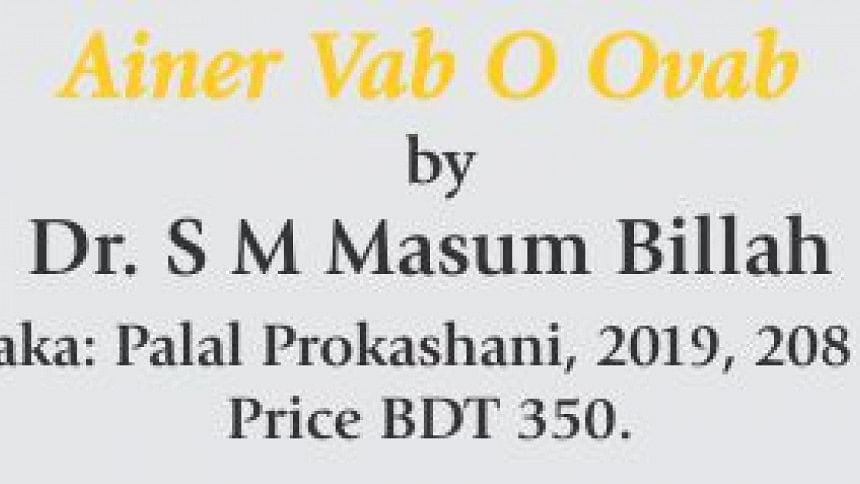Ainer Vab O Ovab


Ainer Vab O Ovab (the art and inert of laws), authored by Dr. S M Masum Billah, is one of those books that you should not judge by its cover. The gloomy looking, gravel pictured book holds inside it an opposite realm of unparalleled “legal literature” that tickets the ride of a journey into the philosophy of law (“ainbiggyan: maather parer durer desh”).
The book mainly carries the author's view on diverse legal issues in catchy non-legal headings – “shudhi brindo”, “rohingya shoronarthi: biye o ainmontrir portia syndrome”, “erotic justice”, “tobo oncholo chhaya”, “odvut chhatim” to name a few. The topics span from the definition of law (“law like love”) to the characterisation of our legal system (“raag o ninder rajniti kingba naya bichar”- anger, politics of blame and justice).
Dr. Billah writes the book rather in an unconventional language with the inclusion of transliteration words. It will be apt to hold the opinion that the author attempts to build a bridge between his enamour for literature and love for the law with his writings.
Perhaps, the name art and inert of law is derived from two different viewpoints: one takes the common opinion of law being unpleasing, the other views law as an art of words and a means of communication.
The law is there everywhere is our life, and it can be viewed from a simpler approach – if looked at differently; is what the book preaches. Dr. Billah raises issues, questions them and casually leaves them to the readers for their judgments. He takes refuge to jurists to make his point in a literary gesture. That is enticing to any reader.
One may agree or not, he adds twists to concepts, and from that I assume the writer want to make the law sing for the “un-people” or the socially downtrodden. One theme is very clear from Dr. Billah's lines - he sees law through the lens of the disadvantaged and while viewing so, he argues for a native jurisprudence which will read the value of sweat, tears and blood of the people.
Dr. Billah favours a dialogical constitutionalism capable of harmonising the contradictions of our society. Several other offerings in the book look intellectually compelling. Dr Billah attributes, for example, the contemporary problems to the gap between “word” and “world” (zobaner justice), argues for a lucid law drafting culture (digital security law) and situates law into history (“Cornwallis O Ripon: Nam O Bhumikar owponibeshik dai”).
In a letter written in the memory of Chief Justice Mustafa Kamal, Dr. Billah wonders that whether law should value emotion; while in the letter written to Professor Dr. Mizanur Rahman, he raises the need of charismatic law teaching to fashion a human rights culture in Bangladesh and finally, he relates prime minister Shekih Hasina's economic democracy (“hasinomics”) to the idea of our social justice. Thus, Ainer Vab O Ovab is a serving of legal matter onto a non-legal platter.
The book suffers from some anomaly, and one may allege spelling frailty. Nonetheless, it is undoubtedly a trend breaker in the story of our law publications. We wish wider readership of this book.
The writer is a student of law, University of Dhaka.

 For all latest news, follow The Daily Star's Google News channel.
For all latest news, follow The Daily Star's Google News channel. 



Comments